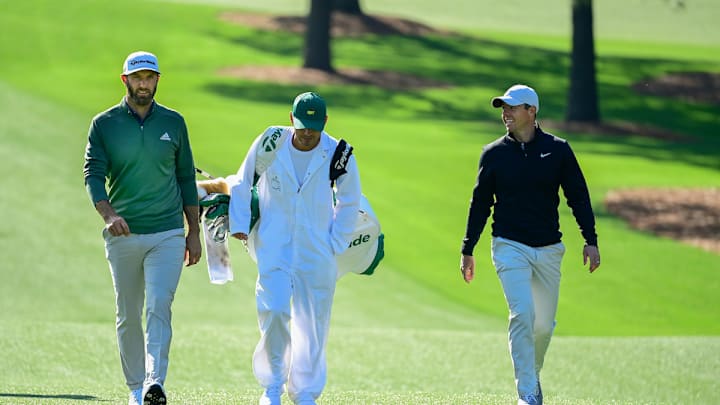So, Masters doesn’t start until back 9 on Sunday, huh?

Thank God the Masters doesn’t really start on the back nine Sunday. Man, what a drag that would be. The best TV week of the year would shrink into something barely longer than Thanksgiving dinner, which is how the event was presented to the public not so long ago. Augusta National didn’t allow CBS to provide 18-hole coverage of the final round until 2002. We now get 18 hours of live action over the four days, plus all the Internet options for the junkies and those with a financial stake.
If it goes without saying that the last nine holes produce the finest two hours in sports, the old line about the tournament beginning there merely underscores the high-end drama and remarkable scoring swings that have characterized the Masters for decades. It’s a fascinating test of golf because the difference between a good shot and a bad one can be so small. This reduced margin for error leads to greater rewards and harsher penalties, which creates rapid movement on the leaderboard and a distinct brand of intoxicating competitive theater.
A missed fairway at the U.S. Open basically costs the player half a stroke. Missing 3 yards right on the second shot into Augusta National’s par-5 13th, however, can destroy a contender’s weekend. He’s thinking eagle and walks away with a bogey. It’s a gold mine to some, a land mine to others, but for all the Masters won and lost on the closing half, the front nine is generally considered the tougher of the two.
The fourth, fifth and seventh all have been lengthened in recent years and are among the toughest holes on the course. The devilish little third is one of the best short par 4s anywhere. To say the tournament starts on Sunday’s back nine, however whimsical, is to shortchange the outward side its due. Here are five men whose heartiest pursuit of a green jacket disappeared before they arrived at the 10th tee.
Craig Parry (1992) – The Australian nicknamed “Popeye” forgot his can of spinach on a day that began with him holding a tenuous one-stroke lead on Fred Couples, the overwhelming crowd favorite who sat atop the Official World Golf Ranking at the time. Parry’s attempt to spoil the Sunday party was over early; he bogeyed five of the last seven holes on the front and finished T-13, seven behind Couples. Although some would claim the Aussie was derailed by gallery noise in that final pairing with America’s Mr. Popular, it’s tough to blame seven three-putts and a 78 on a bit of background clatter.
Greg Norman (1996) – When it comes to self-destruction, nothing can match the Shark’s ghastly collapse on an afternoon that was supposed to become a long-overdue exorcism of his Masters demons. Leading Nick Faldo by six shots on the first tee, Norman saw his edge dwindle to two after he inexplicably played for a front flag at the ninth and spun his ball off the hilltop green. It led to a bogey with massive ramifications, as a player marred by a deep history of unsavory Sundays once again appeared incapable of stanching the bleeding. Those who choose to remember might tell you that Norman lost this tournament with water-ball doubles at the 12th and 16th, but it was over long before that. He was a defeated man as he strode to the 10th tee, allowing Faldo to seize all the momentum after a pair of early bogeys and the ill-advised approach into the ninth. Golf’s ultimate horror show.
Jeff Maggert (2003) – One of the craziest Masters ever featured Maggert, who led by two after 54 holes, finish solo fifth, five strokes out of a Mike Weir-Len Mattiace playoff. Having decided to lay up with a 2-iron at the 350-yard third, Maggert malfunctioned when his ball settled into the farthest of four bunkers bordering the left side of the fairway. His second shot caromed off the lip and hit him in the chest, a two-stroke penalty that led to the crack, “my reflexes aren’t what they used to be.” Speaking of cracks, Maggert needed to hole a 20-footer for a triple-bogey 7. His lead gone, he would fail to get closer than two on the back nine.
Stuart Appleby (2007) – Rarely have first-tee jitters ever been more obvious than when 54-hole leader Appleby, the third Australian on this list, lost his drive 40 yards right on the opening hole en route to a double-bogey 6. Perhaps it had something to do with the other member of the 2:15 p.m. pairing, Tiger Woods, who had long since secured a reputation for raising the anxiety levels of those in the hunt at a major championship. Woods himself would double the 13th and lose by two to Zach Johnson, a point by which Appleby was pretty much out of it. He did well to make a 6 at the first after his drive sailed deep into the trees near the media center. His confidence rattled, Appleby made just one birdie all day to finish T-7, the irony being that he’d earned his own reputation as one of the best wind players in the world by then. Few weekends at Augusta National have been breezier than the one in ’07.
Brandt Snedeker (2008) – He grabbed a share of the lead with Trevor Immelman at 10 under after an eagle on the par-5 second, then suffered a meltdown you wouldn’t wish on an IRS auditor with cigarette breath. Sneds bogeyed the third, sixth, seventh and ninth to fall four back, providing Immelman a clear path to the biggest and most improbable victory of his career. The sight of a teary-eyed Snedeker in the media center afterward was a reminder of how badly some guys want it. In this case, perhaps too much, as one of the PGA Tour’s top putters managed just six pars on Augusta National’s wind-hardened greens. Immelman would win despite a 75, the highest final-round score by a champion in 46 years. Snedeker would fumble away another golden opportunity in 2013, when Adam Scott beat Angel Cabrera in a playoff. Sneds vowed he’d win the Masters some day after that loss. We’re still waiting.
Sign up to receive the Morning Read newsletter, along with Where To Golf Next and The Equipment Insider.
